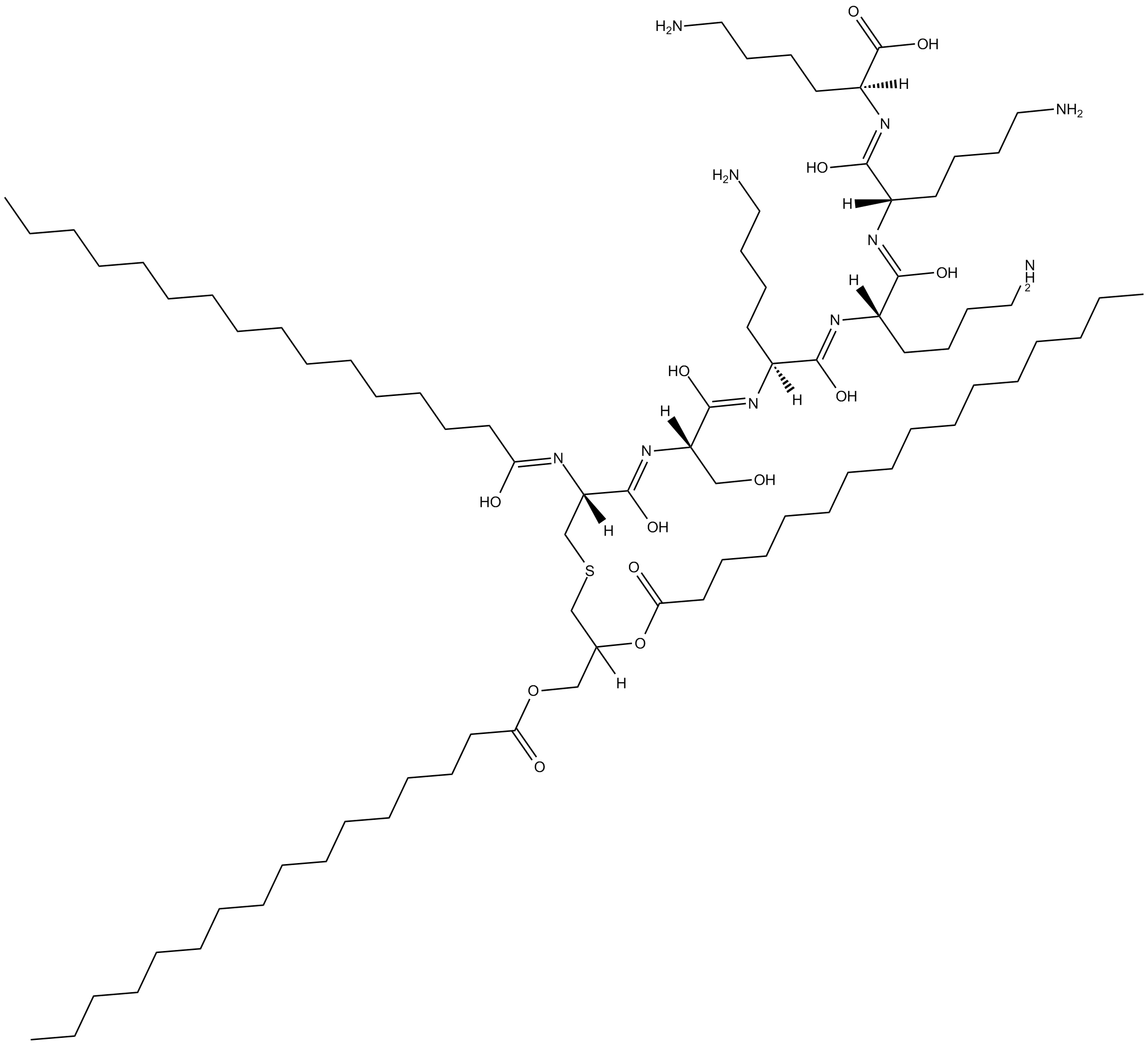Pam3CSK4 (Synonyms: Pam3Cys-Ser-(Lys)4) |
| Catalog No.GC10273 |
Pam3CSK4 (Pam3CysSerLys4) is a synthetic triacylated lipopeptide (LP) and a TLR2/TLR1 ligand?agonist with an EC50 of 0.47 ng/mL.
Products are for research use only. Not for human use. We do not sell to patients.

Cas No.: 112208-00-1
Sample solution is provided at 25 µL, 10mM.
Pam3CSK4 (Pam3CysSerLys4) is a synthetic triacylated lipopeptide (LP) and a TLR2/TLR1 ligand agonist with an EC50 of 0.47 ng/mL[10]. Pam3CSK4 mimics the acylated amino terminus of bacterial LPs. Bacterial LPs are a family of pro-inflammatory cell wall components found in both Gram-positive and Gram-negative bacteria. These bacterial LPs are recognized by TLR2, a receptor that plays a pivotal role in detecting a diverse range of pathogen-associated molecular patterns (PAMPs).Recognition of Pam3CSK4, a triacylated LP, is mediated by TLR2 which cooperates with TLR1 through their cytoplasmic domain to induce the signaling cascade leading to the activation of NF-κB [1].
In HepaRG cells, Pam3CSK4 shows a broad antiviral activity against HBV. Pam3CSK4 is a well-characterized and specific TLR1/2 ligand[2]. The anti-HBV effect of Pam4CSK4 is dependent on TLR1/2 and its adaptor MyD88, targeting TLR1 or TLR6 with specific siRNA do affect the feed-forward expression of TLR2 in the context of Pam3CSK4 activation ; but invalidation of TLR1 led to a reduced inhibitory effect of Pam3CSK4. The low functional level of TLR2 was sufficient to produce the therapeutic effect of Pam3CSK4[4,5].Thus confirming that Pam3CSK4 likely signals through TLR1/2 heterodimers in hepatocytes[3].
Activation of TLR2/1 heterodimers by Pam3CSK4 mediates pain and itching, whereas activation of TLR2/6 heterodimers by lipoteichoic acid (LTA) or yeast glycan leads to itching[9]. As a cutaneous regulator, IL-13 activates sensory neurons and participates in the initiation of AD and itch[7]. IL-13 alone did not lead to a significant increase in scratching number,TLR2 promotes IL-13 signaling in sensory neurons. Innate TLR2 signaling not only promotes itch and pain but convert transient TH2 cell-mediated dermatitis into persistent inflammation which is linked to chronic human AD[8]. In mice pretreated with Pam3CSK4, IL-13 injection caused approximately twice as many scratches as vehicle injection[6]. Pam3CSK4 enhances IL-13-induced calcium transient in sensory neurons and elevates IL-13-induced Itch-like behaviours in mice.
[1]: Ozinsky A, Underhill DM, et,al.The repertoire for pattern recognition of pathogens by the innate immune system is defined by cooperation between toll-like receptors. Proc Natl Acad Sci U S A. 2000 Dec 5;97(25):13766-71. doi: 10.1073/pnas.250476497. PMID: 11095740; PMCID: PMC17650.
[2]: Lucifora J, Xia Y, et,al. Specific and nonhepatotoxic degradation of nuclear hepatitis B virus cccDNA. Science. 2014 Mar 14;343(6176):1221-8. doi: 10.1126/science.1243462. Epub 2014 Feb 20. PMID: 24557838; PMCID: PMC6309542.
[3]: K. Visvanathan, N.A. Skinner, et al. Regulation of Toll-like receptor-2 expression in chronic hepatitis B by the precore protein. Hepatology. doi:10.1002. 2006.
[4]: Xiao S, Lu Z, et,al. Innate immune regulates cutaneous sensory IL-13 receptor alpha 2 to promote atopic dermatitis. Brain Behav Immun. 2021 Nov;98:28-39. doi: 10.1016/j.bbi.2021.08.211. Epub 2021 Aug 13. PMID: 34391816.
[5]: Erickson S, Heul AV, et,al. New and emerging treatments for inflammatory itch. Ann Allergy Asthma Immunol. 2021 Jan;126(1):13-20. doi: 10.1016/j.anai.2020.05.028. Epub 2020 Jun 1. PMID: 32497711.
[6]: Oetjen LK, Mack MR, et,al. Sensory Neurons Co-opt Classical Immune Signaling Pathways to Mediate Chronic Itch. Cell. 2017 Sep 21;171(1):217-228.e13. doi: 10.1016/j.cell.2017.08.006. Epub 2017 Sep 7. PMID: 28890086; PMCID: PMC5658016.
[7]: Kaesler S, Volz T, et,al. Toll-like receptor 2 ligands promote chronic atopic dermatitis through IL-4-mediated suppression of IL-10. J Allergy Clin Immunol. 2014 Jul;134(1):92-9. doi: 10.1016/j.jaci.2014.02.017. Epub 2014 Apr 1. PMID: 24698321.
[8]: Liu T, Gao YJ, et,al. Emerging role of Toll-like receptors in the control of pain and itch. Neurosci Bull. 2012 Apr;28(2):131-44. doi: 10.1007/s12264-012-1219-5. PMID: 22466124; PMCID: PMC3347759.
[9]:Wang TT, Xu XY, et,al. Activation of Different Heterodimers of TLR2 Distinctly Mediates Pain and Itch. Neuroscience. 2020 Mar 1;429:245-255. doi: 10.1016/j.neuroscience.2020.01.010. Epub 2020 Jan 16. PMID: 31954829.
[10]:Irvine KL, Hopkins LJ, Gangloff M, Bryant CE. The molecular basis for recognition of bacterial ligands at equine TLR2, TLR1 and TLR6. Vet Res. 2013 Jul 4;44(1):50. doi: 10.1186/1297-9716-44-50. PMID: 23826682; PMCID: PMC3716717.
Average Rating: 5 (Based on Reviews and 38 reference(s) in Google Scholar.)
GLPBIO products are for RESEARCH USE ONLY. Please make sure your review or question is research based.
Required fields are marked with *




